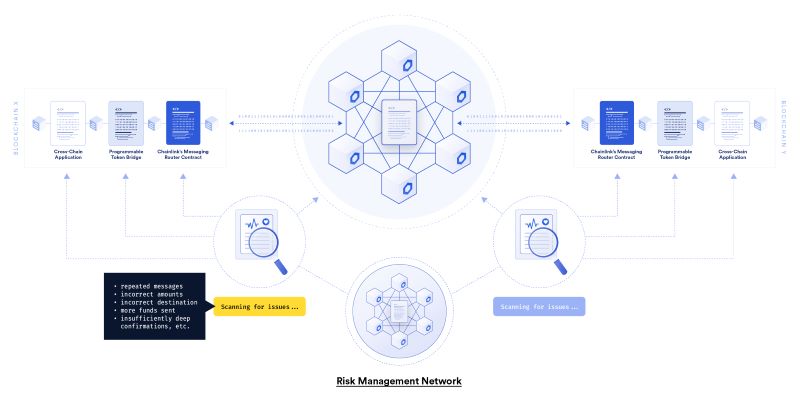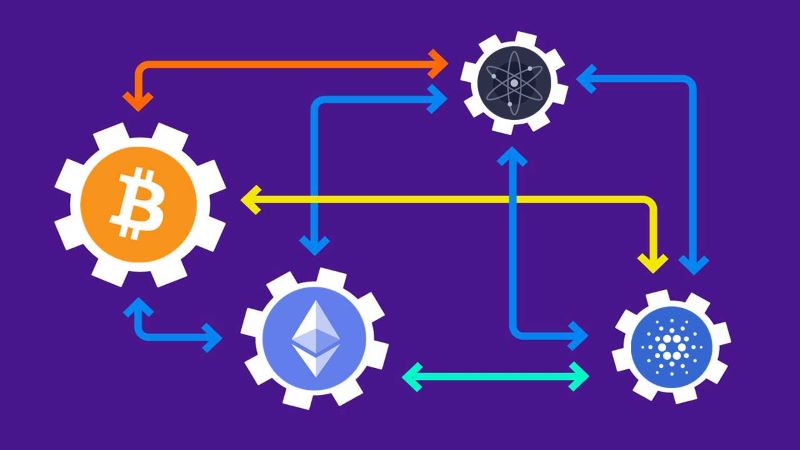Cross-Chain Explained: Unleashing Multi-Blockchain Superpowers!
Imagine holding a magic key that unlocks not just one door, but an entire hallway of them. That’s the kind of digital wizardry What is Cross-chain technology offers in the blockchain universe. This isn’t just any tech buzzword; it’s the backbone of a system that lets different blockchains talk to each other. It means goodbye to isolated crypto islands and hello to a world where Bitcoin high-fives Ethereum! Stay with me as I break down how this groundbreaking tech works and why it’s shaking up everything from simple swaps to the towering world of DeFi.
Understanding the Basics of Cross-Chain Technology
The Rise of Blockchain Interoperability
Imagine a world where you can easily move stuff, like your money or your favorite game character, between different play spaces. That’s what blockchain interoperability is like. It’s a big word, but just think of it as fitting puzzle pieces from different sets together. It lets us send value, like coins, from one blockchain to another with ease. This magic trick happens thanks to smart people creating special ways for blockchains to talk to one another.
Now, why should we care? Simple! We want all our different digital coins to work together, kind of like how we use money in different shops. Blockchain interoperability makes this happen. It’s not just cool; it’s super handy and can change how we use our digital things.
The Role and Function of Multi-Chain Platforms
Next up is this cool thing called multi-chain platforms. They’re like universal remote controls for TVs. With one, you can control lots of different TVs, or in this case, blockchains. A multi-chain platform can handle lots of transactions between different blockchains at once. It’s like being able to play different video games at the same time without having to switch the console off and on.
How do they do it? With smart tech talk called interoperability protocols. Think of it as learning lots of different handshakes so you can be friends with many types of people. And because they speak all blockchain languages, they make sure no one loses out – every coin or token gets to where it needs to go safely.

But wait, it isn’t just moving things around. Multi-chain platforms also help keep our digital money safe with things like atomic swaps. This is a fancy way to trade without worry, kind of like swapping lunch items with your friend, but you both have to trade at the same time.
And we can’t forget bridges in cryptocurrency. They connect islands of blockchains so they can move things between them. It’s like having bridges in a video game that let you cross from one world to another, bringing your treasures with you.
In short, cross-chain technology lets us play across many digital worlds with ease. It keeps things safe, fast, and lets us have one big party instead of many small ones. It’s like having a friend in every game you play, a key for every door, and a passport for every country, all in one. Neat, right?
Facilitating Seamless Transactions Across Blockchains
How Atomic Swaps Contribute to a Unified Crypto Ecosystem
Imagine two kids, each with a different kind of toy, wanting to trade with each other. They need to agree on a fair swap, right? That’s what atomic swaps do, but for digital coins. Atomic swaps let you change one kind of crypto coin for another, without a middleman. It’s like a magic trick where you close your hand around a penny and open it to find a dime.
These swaps use a special kind of code called a smart contract. Think of a smart contract like a robot that makes sure each person gets what they were promised. If someone tries to cheat, the robot cancels the trade. No harm, no foul! All of this takes place on what we call cross-chain technology, which is where the different kinds of digital money, called blockchains, can talk and trade with one another.
Atomic swaps are cool because they keep things between the two parties. Instead of needing a third person to make sure everyone’s honest, the smart contracts do that job. They’re a big part of a united crypto world where all coins can get along and work together.
The Significance of Decentralized Exchanges (DEX) in Cross-Chain Transactions
Now, think of a place where anyone can trade toys with each other, and no one needs to be in charge. That’s what decentralized exchanges (DEX) are like. They let people swap their digital coins directly with each other. It’s like kids trading cards on the playground. Nobody needs to ask the teacher for help; they just trade.
This playground, or exchange, is super special because it works with more than one kind of blockchain. These exchanges use blockchain interoperability, which is a fancy way of saying they let different blockchains talk to each other. So, if you have coins on Blockchain A but need some from Blockchain B, a DEX helps you swap them easily.
What’s great about DEXes is that they don’t hold on to your coins. You’re in control of your own money, trading it on your terms. If Atomic Swaps are like a magic trick, then DEXes are like a magic show, dazzling with all the different tricks you can do.
With the help of these tools—atomic swaps and decentralized exchanges—people everywhere can trade their favorite coins faster and safer than ever. It makes the world of digital money more fun, more fair, and more open for everyone to play. And as a Blockchain Solutions Architect, I help build this playground, making sure it’s safe and everyone can find their preferred toy… or in this case, coin!
The Architecture of Cross-Chain Communication
Building Bridges: Linking Disparate Cryptocurrencies and Tokens
Imagine if you have a train that runs on one set of tracks. Now, think about how handy it would be if that same train could move onto other tracks to reach new stations. That’s what bridges in cryptocurrency do! They let your digital money move between different blockchains. It’s like magic for your tokens, helping them travel from one blockchain network to another without any fuss.
This isn’t just some cool trick. It is important because it lets people use their tokens in more ways and makes everything work better together. Just like towns connected by bridges prosper more, so do cryptocurrencies and tokens when they can mix and match.
Implementing Advanced Smart Contract Functionality for Cross-Ledger Interactions
Now let’s add another layer to the fun. Do you know how games become more exciting when you learn new moves? The same goes for blockchains with smart contracts. These are like secret codes that tell your tokens what to do and when. And the best part is they’re super smart – so once you tell them what to do, they do it all by themselves!
When we use advanced smart contracts, we can set up rules for tokens to move between blockchains. Think of it like setting up a play in a football game. Each player (or token) knows where to go and what to do to score a touchdown. It’s teamwork at its best, and it means you can do more with your money.

Smart contracts make everything safer too. They’re like a promise that cannot be broken. This is huge, because when you’re moving tokens across different places, you want to be sure they won’t get lost. These clever contracts are the glue that keeps everything tied together neatly.
By making sure different blockchains can talk to each other and work together, we open up a world of possibilities. It’s like being able to take your toy from one playground to any other one in town and still have just as much fun. That’s what I do every day – make sure everyone’s toys play nice, no matter where they are. And by toys, I mean your precious tokens!
So next time you hear someone say ‘cross-chain communication’, just think about trains jumping tracks, football plays, and secret codes that help your money move smart and safe. It’s all about creating a world where our digital tokens have superpowers to hop between blockchains and make our virtual wallets way cooler.
Cross-chain technology is like a key to a treasure chest – it unlocks so much value we didn’t even know was there. It’s not just changing the game; it’s making a whole new one where everyone gets to win. And you can bet I’m right there, helping to build it and make sure it runs like a dream!
Enhancing Liquidity and Efficiency in Cross-Chain DeFi
Leveraging Liquidity Aggregation for Superior DeFi Solutions
Imagine walking into a huge mall. Each store offers different things you love. This is like DeFi, or decentralized finance. It’s a big market with lots of services. But there’s a twist. What if all the stores used different currencies? You’d have to swap money at each one. It’s a hassle, right?
Here’s where cross-chain tech shines. It lets different blockchain networks talk and trade with each other. Think of it as having a universal card that works in all stores. This makes it easier to move assets across blockchains. You don’t need to swap currencies all the time.
But there’s more. Liquidity means having enough cash or assets to trade without delay. More liquidity means a smoother market. Cross-chain tech helps by pulling liquidity from many blockchains into a single pool. This is like all the stores in the mall pitching in to make one big ‘currency pot’. All users get more options without extra trouble.
This helps DeFi give better service. Users get more chances to make money and find good deals. It’s a win-win for everyone. New services pop up, and the whole system grows. Keeping this big ‘currency pot’ filled is key. And it’s what cross-chain tech is all about.
Exploring the Impact of Layer 2 Solutions on DeFi Cross-Chain Integration
Layer 2 solutions are like express lanes on a highway. They move traffic fast, avoiding jams. On blockchains, they bypass slow, crowded networks for quicker trades.
These solutions help cross-chain DeFi work smooth. They let blockchains scale, or grow, without losing speed. It’s like adding more express lanes for all the extra cars. Users can do more without long waits or high fees.

When you add Layer 2 solutions to cross-chain DeFi, magic happens. More trades can go on at the same time, from more places. This boost in efficiency means things cost less to do. It’s cheaper for users, and the network stays fast.
Still, we must keep an eye on security. Like in cross-chain bridges, which let assets move between blockchains. They must be strong and safe. Weak bridges can lead to theft or lost assets. We work hard to find and fix holes that might let hackers in. Safety in cross-chain tech is a top priority.
Building a better DeFi space is not simple. But with cross-chain tech and Layer 2 solutions, we’re getting there. Think of it as building a fast, safe, and easy way to shop in that huge mall. Everyone gets a better deal, and we all have a great time. This is the future we’re working on, so stay tuned for the ride!
To wrap this up, we’ve explored how cross-chain tech is breaking down walls in the world of blockchain. Starting with the basics, we saw the need for different blockchains to talk to each other and how multi-chain platforms make that happen. We then dove into how atomic swaps and DEXs are changing the game for crypto trading, allowing coins to move smoothly across chains.
We also unpacked the tech behind the scenes – the smart contracts and bridges that let tokens cross from one chain to another without a hitch. And finally, we looked at how all this works to pump more life into DeFi, making it more fluid and fast by stitching together layers and pooling resources.
Long story short, cross-chain tech is a big deal. It’s like a set of superhighways connecting crypto islands, and it’s only going to get bigger. It’s powerful stuff, and I’m excited to see where it takes us next. Keep your eyes on this space – it’s moving fast, and you won’t want to miss what comes next!
Q&A :
What exactly does “cross-chain” refer to?
Cross-chain technology refers to the interoperability between two or more blockchains, allowing them to communicate with one another and exchange information and assets. This innovation is pivotal in the blockchain ecosystem as it enables the transfer of value and information between different blockchain networks, which traditionally operate independently.
How does cross-chain communication work?
Cross-chain communication operates through the use of certain protocols and mechanisms designed to connect disparate blockchain networks. These include bridges, sidechains, and interoperability protocols that enable assets and data to move between chains without central intermediaries, thus creating a more interconnected and functional blockchain landscape.
What are the benefits of using cross-chain technology?
The employment of cross-chain technology provides several benefits, including enhanced liquidity as assets can move freely across different ecosystems, increased scalability by offloading transactions to less congested networks, and improved flexibility due to the broader accessibility of disparate platforms and services.
Are there risks associated with cross-chain transactions?
Like any technological innovation, cross-chain transactions do come with their own set of risks. These include smart contract vulnerabilities, security risks inherent in the bridges that interconnect blockchains, and potential centralization concerns if the interoperability solutions themselves become overly dominant or controlled by a few entities.
What kinds of projects use cross-chain technology?
Numerous projects across the blockchain space utilize cross-chain technology, ranging from decentralized finance (DeFi) applications that require asset transfers between networks, to non-fungible token (NFT) marketplaces that want to expand their reach across multiple blockchains. The technology is also employed by cross-chain data platforms and blockchain agnostic dApps that aim to be accessible to a wider user base.


